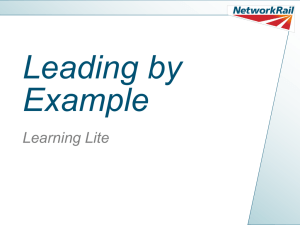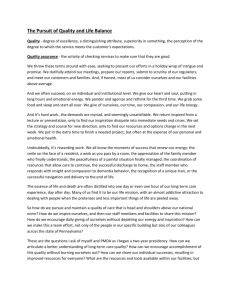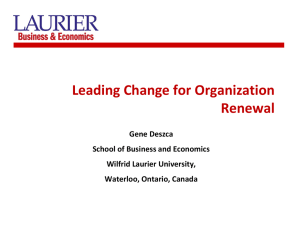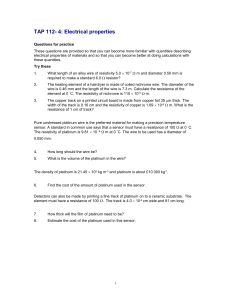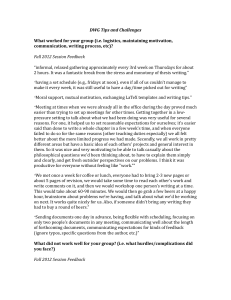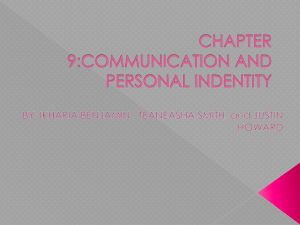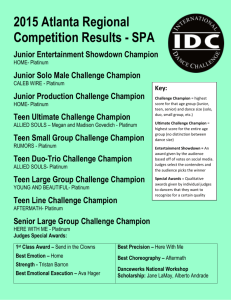Read - Theodore Parker Church
advertisement
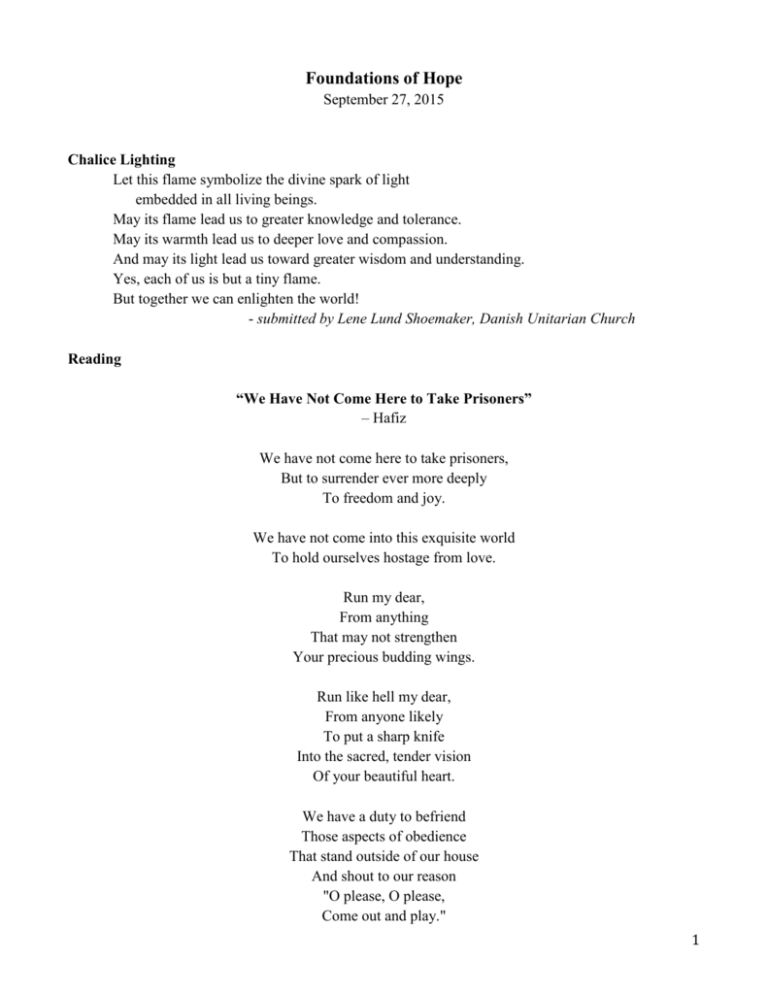
Foundations of Hope September 27, 2015 Chalice Lighting Let this flame symbolize the divine spark of light embedded in all living beings. May its flame lead us to greater knowledge and tolerance. May its warmth lead us to deeper love and compassion. And may its light lead us toward greater wisdom and understanding. Yes, each of us is but a tiny flame. But together we can enlighten the world! - submitted by Lene Lund Shoemaker, Danish Unitarian Church Reading “We Have Not Come Here to Take Prisoners” – Hafiz We have not come here to take prisoners, But to surrender ever more deeply To freedom and joy. We have not come into this exquisite world To hold ourselves hostage from love. Run my dear, From anything That may not strengthen Your precious budding wings. Run like hell my dear, From anyone likely To put a sharp knife Into the sacred, tender vision Of your beautiful heart. We have a duty to befriend Those aspects of obedience That stand outside of our house And shout to our reason "O please, O please, Come out and play." 1 For we have not come here to take prisoners Or to confine our wondrous spirits, But to experience ever and ever more deeply Our divine courage, freedom and Light! (The Gift ~ versions of Hafiz by Daniel Ladinsky) Sermon Timeless Surrender Rev. Anne Bancroft I love it when things go like this [clasps hands together with fingers open] – when one aspect of our lives comes into and feeds another and things feel – even fleetingly – like they might make some sense. Have any of you had that experience? I imagine we so easily sense the opposite – when things are clashing – time and priorities, when the absence of light and our chasing after it burns a part of ourselves, like the fox, or the possum. Some things came into interesting symmetry for me this week. Aside from attending to various legal concerns – none of which I take lightly, by the way – I have been keeping an eye and ear open for what makes sense to share. The topic we've got going for the month of October just happens to have been the topic of the lead article in the New York Times Magazine last week, and it gave me pause to celebrate [hands clasping] this. What we're looking at this month – our theme, if you will – is time and location – the intersection of where we find ourselves in our moments on this earth, both geographically and historically. We can all notice aspects of our lives that but for the time we are living in, or the location, things might be very different for us. So, two weeks ago, Gordon Gibson helped us see what Selma was and how Selma continues. Rev. Sarah Napoline last week considered our tradition in this current time and place. And to my delight, I discovered in last Sunday's article an additional symmetry in what I wanted to speak with you about today. On October 11, the New York Times published the Culture Issue for the magazine. Wesley Morris begins the feature article, called “The Self in the Age of Anything Goes,” by writing about the movie, “The Intern.” In the movie, Robert De Niro plays a retired professional who goes back to work as an intern for Anne Hathaway, a young executive. Morris describes “The Intern” as both a complaint against the present and a pining for the past, but observes an acceptance that "we are where we are. And," he opens the next paragraph, "where are we?" Where are we? Great question. Time and location. Where are we? 2 This could be considered a reflection on here and now relative to having lived in a different century, perhaps – how each of our lives might have been different. Or a reflection on where we are – individually and culturally – today as opposed to ten or twenty years ago. How has this very time and place located what serves us or challenges us, and might there be something consistent irrespective of where we find ourselves? Morris suggests that right now we are ". . . in the midst of a great cultural identity migration. . . . Gender roles are merging. Races are being shed. In the last six years or so, but especially in 2015, we've been made to see how trans and bi and poly-ambi-omni we are." He gives copious numbers of examples about how things are rapidly morphing in our cultural self-perceptions, some of which we'll look at next week, actually. He touches on books, movies, music – all kinds of social indicators. But he ends by suggesting that we are rapidly moving away from vertical self-perceptions or definitions, the traditional dividing blocks that informed our identities (like age, or ethnic identity, or religious affiliation), to more horizontal perceptions, more open and fluid and malleable. "We're daring to erase the segregating boundaries, to obliterate oppressive institutions, to get over ourselves." He ends with this quip: "The transition should make us stronger – if it doesn't kill us first." We are where we are. Where are we? The question that popped up for me, as I mentioned earlier and even before seeing last week's magazine, was whether everything is time- and space-dependent. Particularly in the arena of the spirit, aren't some things, for lack of a better word, universal across time? Aren't some things timeless? Well, if anything was or has been, I would have thought the Golden Rule was pretty timeless, right? The idea that we treat others as we would be treated is consistent across the religious spectrum, and has been a cultural staple for – I don't know – at least 5,000 years? I have yet to identify a tradition that does not recognize some form of this sentiment as foundational to human relations, that we treat others as we would be treated. Last week, in a conversation with Melissa, our religious educator, I heard about the Platinum Rule. Not knowing about it made me feel VERY out of the loop! Now, anyone who has shopped for – oh, let's say a ring, perhaps – has likely learned that metals have various strengths. Silver is actually fairly pliable; gold less so, and platinum is "wicked strong." Whoever came up with the name for the Platinum Rule knew that, no doubt. The Golden rule says do unto others as you would have them do unto you, right? The Platinum Rule says do unto others as they would have done unto them. It mentions the Golden Rule as the predecessor . . . seriously??!! The Golden Rule is considered to be a predecessor to a new version? Where have I been? Aside from the version of the rule that was on the TV sitcom “How I Met Your Mother” – which was a total variation on the one we're talking about – the Platinum Rule seems fairly consistently applied to 3 business environments, particularly service work. I gather it was coined in the 70's by Milton Bennett, who was a cross-cultural researcher, and recommended it as a way of calling attention to varying cultural expectations. There was a book published about it in 1998 that has to do with being successful by anticipating what others expect. I actually found an article about a Double Platinum rule that suggests we should "treat others the way they don't even know they want to be treated." (http://www.hotelonline.com/News/PR2007_2nd/Jun07_GoldenRule.html) But the idea of the basic Platinum Rule must have spread beyond business environments, because Melissa said it was all over the New York schools when she was teaching in Manhattan, and it was mentioned last week by one of our children as something they had also learned in school. One example to clarify its use in a social situation is the following: I like having doors held open for me, but Jane prefers to open her own doors. Instead of insisting that she shut up and let me open her doors, I abide by the Platinum Rule, and I let her open her own doors when she wants to.1 Regardless of whether we agree that the Platinum Rule has more value in social interactions than our age-old standard, the Golden Rule, it does indicate yet another shift, another alteration in our understanding of how we are in relationship in our lives, particularly in a world that is increasingly interdependent across cultures and economies. Remember Wesley Morris? "The transition should make us stronger – if it doesn't kill us first." Curiously, Morris's reference to horizontal vs. vertical has found resonance in a new book by speaker and columnist Diana Butler Bass, called Grounded. Instead of referencing cultural identity, her writing is about religious identity, specifically how we understand ideas about the divine, about God, if you will. She notes that in the 21st century "top-down institutions and philosophies are weakening – [which] includes top-down religions."2 She suggests there is a shift in the here and now, from a three-tiered, vertical construct to a "theologically flattened world."3 Instead of God being somewhere up high, a celestial being, an in-the-clouds and distant entity, separate from humanity, she notices now a "cultural language of divine nearness [that] has come to surround us."4 It is an "alternative theology," she says, "that of connection and intimacy."5 It is a path "that enfolds the mundane and the sacred. . . .This world," she suggests, "not heaven, is the sacred stage of our times."6 http://www.urbandictionary.com/define.php?term=Platinum+Rule Butler Bass, Diana. Grounded. (USA, Harper Collins, 2015) p. 15. 3 Ibid, p. 6. 1 2 Ibid, p. 9. Ibid, p. 12. 6 Ibid, p. 26. 4 5 4 In my mind, I keep seeing the variety of athletes who pump their chests and point to the skies, crediting God – I imagine – for their success. What would it look like if they pumped their chests and then pointed all around them? I admit I feel an affinity for Butler Bass's thinking, if not all the details of her theology. "My soul has a mile-wide mystical streak,"7 she writes. That feels familiar to me. The mystic, like Hafiz from our reading earlier this morning, dwells in the mysterious, the unknown and unknowable, and looks for that which is worthy of celebration. My colleague, Peter Richardson, posted an e-mail recently: "If God is further defined, mystery ceases to be mystery any longer." This cultural movement, this thing that Butler Bass calls a spiritual revolution of our very time and place, is so encouraging to me. Whereas the shift in emphasis from Golden to Platinum rule left me uneasy, this evolution of flattening, of bringing what has been considered distant and unattainable into and among our lives, tangible and relational, feels worthy of our attention. "The new vision," she suggests, "knits spirituality, science, and social justice into an earthy fabric of meaning and faith."8 It confirms that everything we do is radically interdependent with our spiritual lives. We needn't ever be separated from that which is most intimate and loving in ourselves and others. "We have not come into this exquisite world to hold ourselves hostage from love." Those words, offered to us by Hafiz, were written sometime in the 14th century. Wouldn't it be amazing if some time in the near future, humans saw in all things something divine, in the earth, the air, the water, in each other, in all creatures? We would be swimming in a celebration of life. The gift of mystery might be so pervasive we would not feel the need to name it, or divide ourselves by it. Here's one for you. "There are these two young fish swimming along, and they happen to meet an older fish (perhaps one who remembers a time and location where understanding was not so replete). The older fish nods at them and says, ‘Morning, boys. How's the water?’ And the two young fish swim on for a bit, and then eventually one of them looks over at the other and goes, ‘What the hell is water?’"9 Our tradition – this experiment we are engaged in together – at its core is experiential, not ideological.10 And that is the world we may be moving towards – the one that asks not who is love or what is love; who is God or what is God; who is joy or what is joy; but, where and how is love; where and how is joy. We must each ask ourselves, given this time and place we live in, "where are we?" In the midst of keeping up in a world with an ever-growing population and challenge of resources, of technology that we can hardly manage before something new arrives, somehow it does not often feel like the time in Ibid, p. 12. Ibid, p. 117. 9 adapted from Nichols, Wallace J., Blue Mind, (New York: Little Brown, 2014) p. xviii. 10 BYOT, #2, p. 8. 7 8 5 history nor the location for a sentiment as beautiful as surrendering "ever more deeply to freedom and joy." But that, indeed, is our task because it's gone in an instant, this life, and we only get one shot at it. Regardless of what issues or challenges we are struggling with at any given point in time – and there are often many, whether they would be otherwise had we found ourselves in a different time or place – we dare not look back and wonder, "when did I celebrate?" It is timeless to remember "we dare not hold ourselves hostage from love." We have a timeless opportunity to surrender to beauty, to the light that is present to all; to locate our divine courage in each and every moment and space; to be connected to the nameless mystery that is why we're here in the first place. These days, if we want emphasis in our communication, we often see things written in all caps, with periods in between. Imagine these words: BEST.TIME.EVER In this moment, in this space, whenever and wherever you find yourself, that is our timeless surrender. 6

